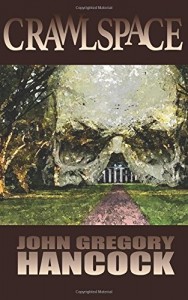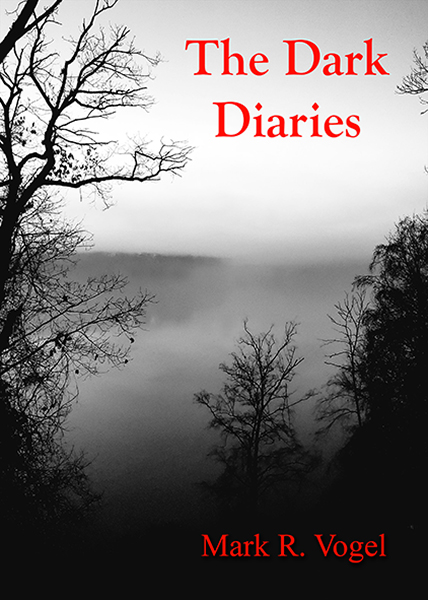
John Gregory Hancock
Artsprocket Publishing
November 22, 2014
Reviewed by Michael R. Collings
Today was a first.
I started and finished a review copy of a novel I received yesterday. That in itself is not unique; if a novel catches my interest, and is not too long, I prefer not to break into the narrative experience.
It was a horror novel, which I was anticipating since I had requested it through Hellnotes. It had a nicely creepy title, Crawlspace, that by itself sent a few shivers down my spine and ultimately proved a pivotal image in the story. And the cover, along with ominous black-and-white interior illustrations, was unsettling, was more than a little upsetting, and was created by the author, John Gregory Hancock.
Horror novel, eerie title, atmospheric cover, unnerving illustrations: yet however effective they all were, none of these were firsts.
The first was that this novel included a “Content Warning.”
I am ambivalent—leaning strongly toward negative—about the notion of “Content Warnings” or “Trigger Warnings.” While understanding that some topics may indeed disturb some individuals, I rarely gave warnings to my students while I was teaching. My subjects ranged from The Epic of Gilgamesh to Milton and the intervening history of epic; from Beowulf to Nineteenth-century Gothic; from Myth to Fantasy to Science Fiction; and from Freshman Composition to Advanced Creative Writing. Any atheists in the classes were not expected to believe Milton’s theology, but they were expected to have read and understood it. Anyone hyper-alert to sexism in language simply had to deal with the opening line of Paradise Lost—“Of Mans First Disobedience and the Fruit…”—and its implications for the whole poem.
In various other classes, students might be required to read Shakespeare’s “The Rape of Lucrece” or Pope’s comic masterpiece The Rape of the Lock. At the core of the Jacobean masque tradition lay Jonson’s The Masque of Blackness, in which the actresses were eleven of the leading ladies of the court and Queen Anne herself…their skin painted black. In its sequel, The Masque of Beauty, the personages would be represented as having been ‘cleansed.’ And as far as non-courtly theater went, women did not appear on stage until the mid-1600s, their parts always being played by young boys; there was no particular indication at the time, however, that the boys were considered cross-dressers or suffered gender dysphoria.
Teaching such literature today, even to university students, could be highly problematical: Hence the suggestion that anything potentially psychologically harmful, personally uncomfortable or distressing, or opposed to students’ individual views should be avoided, if possible. At the very least, such content should be prefaced by a “Trigger Warning.”
Perhaps because of the numerous comments on the social media supporting and decrying such warnings, when I completed my recent science fiction/fantasy/Lovecraftian horror/space opera—Space Operae! A Tale of Three Planets—I decided to include one of my own. In my nearest approximation to the social satire of Jonathan Swift and Alexander Pope, I wrote:
Trigger Dehortation
NO HUMANS—PRE-BORN, POST-BORN, OR OTHERWISE-BORN—WERE INJURED, ABUSED, MAIMED, MUTILATED, KILLED, INSULTED, OFFENDED, SNUBBED, OR OTHERWISE DISCOMMODED IN THE MAKING OF THIS NOVEL.
* * * * *
No humans exist within the space of this story. It would take minimally a million parsecs for the most advanced human spaceship imaginable to cross the indescribably, the unutterably vast distances—to say nothing of the non-Euclidian geometries—separating planet Earth and the topographies posited herein, and no one has time for that.
Space Operae! is about aliens … alien nations, alien worlds, alien Gods. It is, in the most fundamental way, of the Aliens, by the Aliens, and for the Aliens.
That having been said, it must be admitted that some of the creatures encountered may bear faint resemblances to certain scuttling, skittering Terran organisms. Others may—just may—resemble the tenebrous, amorphous, tentacular ancient entities most often found in the conjectural universes of H.P. Lovecraft and his followers. Either way, beyond being discombobulated, crushed like bugs, and otherwise conquered, scathed, and annihilated, no entities in this story assume a cadaverous state. Generally speaking, there is not enough left of them to warrant the adjective.
So, having issued a sufficient warning, I invite the intrepid to sit back, enjoy and, to paraphrase the immortal words of the august Peter Schickele, world-renowned authority on (and, not coincidentally, author of) the works of the infamous P.D.Q. Bach: Be prepared to read things you’ve read before.
Given these points, my concern with Crawlspace is not so much that there is a “Content Warning” as that there doesn’t need to be one. The novel is horror—that much is clear from the cover, from the graphics and text on the back. Yes, as the first two paragraphs of the warning spell out, it is “adult dark horror,” it is “creepy,” it “mentions disturbing or gory things,” it “contains a handful of crude words, discusses adult and sexual topics, and contains one sex scene.”
But combinations of these elements are present in much—if not most—horror. They are, as it were, to be taken for granted, the building blocks of the genre. Beyond that, Hancock handles such elements with a certain distancing of the prose, a care with language, a sense almost of elegance that disarms much potential objection to them.
The third and fourth paragraphs of the warning refer to childhood sexual abuse…and take more space than the actual passage in the novel, which consists essentially of two sentences that restrain themselves to generalizations of “nasty things,” “horrible things,” and “blood.” When I read those warning paragraphs, my first inclination was to jump ahead and see what could be so awful as to merit them; instead, I read the narrative sequentially and, when I finally came to that chapter, simply wondered “Why bother?” Much worse things happen further on in that chapter, more graphically described…more horrific. And that is the nature of the genre.
Crawlspace does itself a disservice, I think, by including a caveat that, in the long run, seems inappropriate, that almost trivializes what is a powerful novel of human passions, greed, cruelty, and self-centeredness and the catastrophic consequences when deeply flawed individuals must confront an entity even more monstrous than themselves.
Ethan Novotny is a psychic, although he prefers the term sensitive. He’s contracted with a television reality program to lead a ghost-hunting expedition into a notoriously haunted house. While few people actually believe in his ability to detect the dead, none, including Ethan himself, realize the extraordinary power he actually possesses, one that will bring out the worst in other entities in the house and in the house itself.
The same is—or was—true of the dead he encounters. Each was extraordinarily susceptible to the invisible world: a World War II soldier whose last act is a desperate attempt at redemption; a nineteenth-century African slave who holds the secret to a magic that can destroy the house…or the world; a child whose lust for blood belies her age and makes a mockery of her illusive innocence.
And a beast that must either be sent back to its own dimension or be released on an unsuspecting humanity.
No one escapes the house without being damaged, physically or psychically. And, what is worse, not even the dead can rest in peace.
Hancock treats his varying levels of time and place carefully, allowing horror to build upon horror. The first touch is a memory: Novotny reliving his first and only experience with an MRI and the resulting agony of claustrophobia. For me, that was perhaps the worst moment in the novel, because I too am highly claustrophobic, I too once endured an MRI that was to this day among the worst experiences of my life; and I too resonated (horrible pun intended) to every word in the passage. From then on, Hancock allows other dimensions, other realities, to intrude upon his characters’ lives, bringing sorrow and suffering and death…and what lies beyond death. The most inoffensive objects transform into vessels of terror and fear: a red-haired doll, a child’s ViewMaster, even Ethan’s beautiful ice-blue eyes.
And the truly good news is that, even though Crawlspace can stand on its own and arrives at a logical and inevitable conclusion, there is yet another story to come—Banyan’s Law: The Origins of Jack Banyan.
- Killing Time – Book Review - February 6, 2018
- The Cthulhu Casebooks: Sherlock Holmes and the Miskatonic Monstrosities – Book Review - January 19, 2018
- The Best Horror of the Year, Volume Nine – Book Review - December 19, 2017
- Widow’s Point – Book Review - December 14, 2017
- Sharkantula – Book Review - November 8, 2017
- Cthulhu Deep Down Under – Book Review - October 31, 2017
- When the Night Owl Screams – Book Review - October 30, 2017
- Leviathan: Ghost Rig – Book Review - September 29, 2017
- Cthulhu Blues – Book Review - September 20, 2017
- Snaked: Deep Sea Rising – Book Review - September 4, 2017


